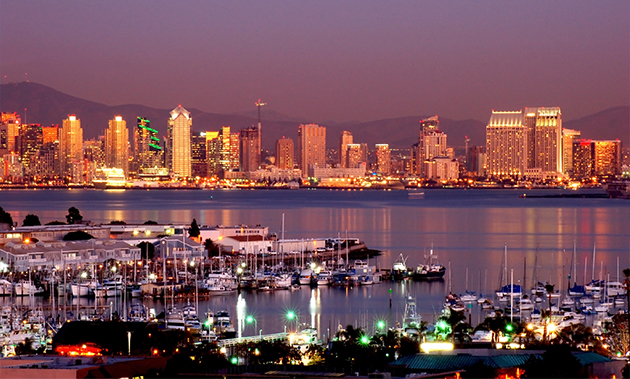That’s exactly the reason. From Wikipedia:
XETV came into existence because of a technical quirk affecting stations in San Diego and Los Angeles. Even after the Federal Communications Commission’s Sixth Report and Order lifted a four-year-long freeze on awarding television construction permits in 1952, signing on a third television station in the San Diego market proved difficult. While San Diego and Los Angeles are not close enough that one city’s stations can be seen clearly over the air in the other, the unique geography of Southern Californiaresults in tropospheric propagation. This phenomenon makes co-channel interference a significant enough problem that the two cities must share the VHF band.[ citation needed ]
By 1952, San Diego (assigned channels 8 and 10) and Los Angeles (assigned channels 2, 4, 5, 7, 9, 11 and 13) already had all but three channels on the VHF band covered. Channel 3 initially had been deemed unusable as a signal because KEYT-TV in Santa Barbara would travel in a straight line across the Pacific Ocean (it would ultimately be allocated to Tijuana Canal Once outlet XHTJB-TV). San Diego’s first two television stations, KFMB-TV (channel 8) and KFSD-TV (channel 10, now KGTV), which were respectively affiliated with CBS and NBC, were among the last construction permits issued before the FCC’s freeze on new television station licenses went into effect. The UHF band, introduced by the FCC after the freeze, was not seen as a viable option; television set makers were not required to include UHF tuners until 1964 as a result of the passage of the All-Channel Receiver Act. Additionally, several portions of San Diego County are very mountainous, and UHF signals do not carry very well across rugged terrain.[ citation needed ]
Complicating matters, the Mexican authorities had allocated two VHF channels to neighboring Tijuana – channels 6 and 12. Since these were the last two VHF channels left in the area, the FCC did not accept any new construction permits from San Diego as a courtesy to Mexican authorities. One of the frequencies, channel 6, had originally been assigned to San Diego before the freeze; it was reassigned to Mexico as a result of the Sixth Report and Order .[4]
Although San Diego was large enough to support three television stations, it soon became obvious that the only way to get a third VHF station on the air would be to use one of Tijuana’s allocations. The Azcárraga family, owners of Telesistema Mexicano (the forerunner of Televisa), quickly snapped up the concession for channel 6, and signed XETV on the air on April 29, 1953.[5] It is the San Diego area’s second-oldest television station after KFMB-TV, which began operations on May 16, 1949.
At its launch, XETV was an independent station, broadcasting programs in both English and Spanish from its studio facilities in Tijuana.[6][7] Channel 6 also established a business office on Park Boulevard in the University Heights section of San Diego, which handled sales accounts from north of the border. The Azcárragas chose to focus XETV toward San Diego and its English-speaking audience because there were more households in that side of the market that had television sets at the time than there were in Tijuana,[8] which did not get its own all-Spanish station until 1960 when the Azcárragas signed on sister station XEWT-TV(channel 12).[7] Owing to its initial bilingual, bi-national audience, XETV billed itself as " The International Station " during its early years.[9]
Joining ABC (1953–1973)[edit]
In January 1953, former ABC programming executive Alvin George Flanagan filed an application with the FCC to supply programming to XETV via microwave relay from San Diego.[10] Flanagan’s request was neither approved nor denied and he took a position with Los Angeles station KLAC-TV (now KCOP-TV) in early 1954.
A subsequent petition by ABC to allow it to transmit network programming across the Mexican border to XETV via microwave relay was approved in November 1955.[11] Pending the outcome of an appeal by KFMB-TV and KFSD-TV, ABC signed an affiliation deal with XETV which allowed channel 6 to carry network programming via film and kinescope; that became effective 5 April 1956[12] and replaced the part-time carriage of ABC programming by the two San Diego-licensed stations.
The original decision was stayed by the United States Court of Appeals due to the decision having been made in the absence of hearings by the FCC; after hearings were held, the FCC upheld the grant in October 1956. KFMB-TV again appealed the grant and the Appeals Court remanded the decision to the FCC.[13] The Commission again upheld the grant on April 22, 1958; in November of that year, KFMB-TV again asked for revocation, based on an ad in Broadcasting which XETV identified itself as a San Diego station.[14]
Throughout XETV’s tenure with ABC, network programs were received via microwave and AT&T cable at the station’s San Diego offices, where they were reproduced (on film or kinescope, and later videotape) and then physically transported to channel 6’s transmission facilities in Tijuana, a practice known in the television industry as “bicycling”. While this arrangement legally circumvented the station’s inability to receive and broadcast a direct network feed from across the international border, it left XETV unable to carry live network programming, such as breaking news events and some sports coverage. The FCC held the option of renewing the authorization on an annual basis, as well as reviewing it if – and when – a third commercial television station signed on in the American side of the market.[15]
XETV cleared most ABC programs, with one exception: an episode of Marcus Welby, M.D. was self-censored, as it depicted an abortion in a Mexican border town at a time when abortion in Mexico was still illegal.[16]















